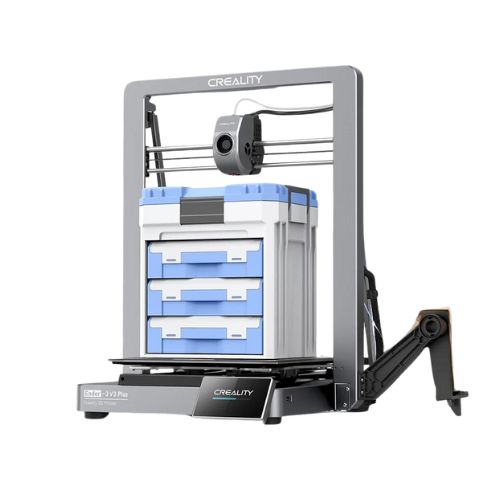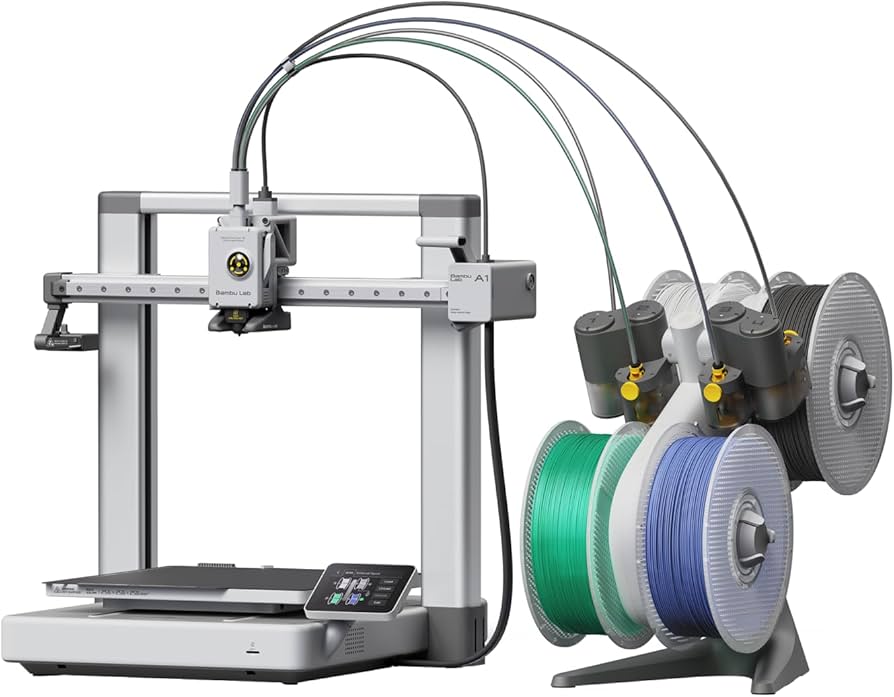Compare Ender 3 V3 Plus vs A1
Comparison between the best 3D printers
Choose the best 3D printer at the best price. The cheapest 3D printers are here.
Buy a 3D printer here with 3D Fila.
 |
 |
|
| Model | Ender 3 V3 Plus |
A1[BUY A1] |
| Printing Material | Filament | Filament |
| Buy Filament for Creality Ender 3 V3 Plus | Buy Filament forBambu Lab A1 | |
| Estimated price | $479,00 | $700,00 |
| Manufacturer | Creality | Bambu Lab |
| Release Year | 2024 | 2023 |
| Print Volume [mm] | 300x300x330 | 256x256x256 |
| Printer Size [mm] | 410x445x577 | 385x410x430 |
| Weight [kg] | 11,5 | 8,3 |
| Power Loss Recovery | YES | YES |
| Enclosed printer | NO | NO |
| Bed Leveling | Automatic | Automatic |
| Filament End Sensor | YES | YES |
| Bed type | Heated | Heated |
| Power supply system | Direct Drive | Direct Drive |
| Standard nozzle | 0,4 | 0,4 |
| Maximum Nozzle Temperature [°C] | 300 | 300 |
| Maximum Bed Temperature [°C] | 100 | 100 |
| Maximum printing speed [mm/s] | 600 | 500 |
| Filament holder | YES | YES |
| Camera for supervision | NO | NO |
| Recommended filaments | PLA, TPU(95A), PETG, ABS, PLA-CF, PETG-CF, CR-carbon | PLA, PETG, TPU, PVA |
| Recommended slicers | Bambu Studio, Super Slicer, Cura, Prusa Slicer, Orca Slicer, Creality Print | SuperSlicer, PrusaSlicer, Cura, OrcaSlicer |
| Maximum Resolution [mm] | 0,1 | 0,1 |
| Processor | ||
| Display | Touchscreen 4,3'' | Touchscreen 3,5 |
| Power Supply | 350 W | 350 W |
| Connectivity | Wifi, Bambu bus, Cartão SD | Wi-Fi, Bambu-Bus, Cartão Micro SD |
| Operating systems | Windows, Linux, Macbook | Windows, Linux, Macbook |
| Date of registration in the system | 2024-05-10 | 2024-07-17 |
| Release date | 2024 | 2023 |
| Extra features | The Ender 3 V3 Plus incorporates significant advancements in 3D printing, featuring a build volume of 300300330mm. It features a Creality operating system based on Klipper, which supports advanced functions such as linear advance and input shaping, and allows precise adjustments through root access or expert mode. The CoreXZ motion system allows a printing speed of up to 600mm/s, with an acceleration of up to 20000mm/s². Equipped with a flexible build plate and a quick-change nozzle with a hardened steel tip, the printer offers simplified maintenance and increased durability. Additionally, the high-speed direct drive technology of the extruder, together with an automatic leveling system and filament end sensors, raise the standard for reliability and efficiency. Compatible with a variety of filaments, including PLA and PETG, the Ender 3 V3 Plus is a robust choice for 3D printing enthusiasts and professionals. | The BambuLab A1 printer features fully automatic calibration, multi-color printing with the AMS system, active flow rate compensation, quick nozzle change with a clip, active motor noise cancellation, a build volume of 256x256x256 mm³, a maximum extruder temperature of 300°C, and a heated bed of up to 100°C. In addition, it has high precision, a machine health management system and an intuitive 3.5-inch touchscreen interface. |
| Support for multiple colors and materials (AMS and CFS) | NO | YES |
Notes * |
||
| Cost-benefit | 7 / 10 | 7 / 10 |
| Hardware | 3.2 / 10 | 4.2 / 10 |
| Tela | . | . |
| Print volume | 4 / 10 | 4 / 10 |
| Performance | 5 / 10 | 4 / 10 |
| [BUY A1] |
Conclusion |
| In conclusion, the comparison between the Ender 3 V3 Plus and the Bambu Lab A1 highlights key differences that cater to different user needs and preferences in the 3D printing space. The Ender 3 V3 Plus offers a larger print volume and exceptional speed capabilities, making it well-suited for users who prioritize larger projects and high-speed printing. Its advanced features, such as the Klipper-based operating system and flexible build plate, enhance its reliability and efficiency. Additionally, its cost-effectiveness makes it an attractive option for budget-conscious enthusiasts. On the other hand, the Bambu Lab A1 presents a more integrated approach to multi-color printing through its AMS system and benefits from advanced calibration and precision features, which are commendable for users seeking high-quality results in a versatile printing environment. The higher price may be justified for those who require specific functionalities, such as professional-grade output and multi-material capabilities. Ultimately, choosing between these two models will depend on individual priorities—whether it's maximizing print size and speed or emphasizing advanced features and material versatility. Both printers receive solid cost-benefit ratings, indicating they are competitive options in their respective categories. |

